7 Powerful Design Trends That Skyrocketed Conversions 80%
In today’s digital world, website design conversion trends are reshaping how brands connect with customers. Whether you’re launching a new platform or planning a redesign, understanding conversion rate optimization design, high-converting web design, and website design best practices is essential. UX design conversion rate strategies and data-driven web design approaches are at the heart of better user experiences and higher conversions. With web design ROI in focus, businesses that invest in conversion-focused design often see website redesign results that outpace competitors. To stay ahead, it’s crucial to adopt design trends that convert and help build lasting customer relationships.
Why Conversion-Focused Design Matters
For businesses looking to increase engagement and boost profits, web design isn’t just about good looks. It’s about getting real results. A strong website that uses conversion-focused design ensures that visitors feel connected, understood, and motivated to act. Small shifts in how a site looks and feels can impact the UX design conversion rate dramatically. The ultimate goal? Higher sales, better customer loyalty, and stronger web design ROI.
In addition, modern brands now prefer data-driven web design strategies. Instead of guessing what works, they study user behavior. They track clicks, scrolling habits, and even where people hesitate. These insights shape smarter designs that are built to perform, not just impress.
The truth is, a beautiful site alone isn’t enough. Without a strategy centered around conversion rate optimization design, businesses risk losing leads and sales. But when you focus on smart UX choices and high-converting web design techniques, your website turns into a growth engine.
Design Trends That Convert: What’s Working Right Now
In the fast-changing world of web design, sticking to old patterns can hold businesses back. That’s why keeping an eye on design trends that convert is critical. The best-performing websites today combine creativity with psychology.
One of the biggest trends driving success is personalization. When a site adapts to user behavior—like showing tailored product recommendations—it creates a smoother, more satisfying experience. Another hot trend is micro-interactions. These small animations (like a button that changes color when hovered over) make a site feel alive and responsive, encouraging users to explore further.
Minimalist layouts are another major force. Cluttered websites overwhelm visitors. Clean, focused designs guide users to what matters most: taking action. Paired with strong calls-to-action and smart placement of elements, minimalist designs make it easier for visitors to say “yes.”
Brands are also embracing vivid colors, bold typography, and immersive storytelling. These techniques grab attention and spark emotion. Combined with the science of UX design conversion rate strategies, they create websites that don’t just look good—they perform.
Keeping your design fresh with website design conversion trends makes sure visitors stay engaged and satisfied, leading to steady growth in web design ROI.

How a Website Redesign Drives Real Results
Sometimes, small updates aren’t enough. A complete website redesign, when guided by website design best practices and data-driven web design methods, can reset how customers experience your brand.
Businesses that embrace full redesigns with a focus on conversion-focused design usually see huge website redesign results. These results come from fixing outdated layouts, slow load times, and confusing navigation. The fresh design introduces better UX flows, faster site speed, and cleaner mobile responsiveness.
Moreover, adopting design trends that convert during a redesign allows brands to modernize their image without losing loyal customers. Instead, it creates more opportunities to impress and retain them. New visitors, too, immediately feel the energy of a sleek, high-performing site, increasing the chances of turning interest into action.
High-converting web design doesn’t just change how a site looks—it changes how it works for the business. With proper planning, a redesign can lead to measurable improvements in mobile app engagement, lead generation, sales, and overall brand loyalty.
The Future of Conversion Rate Optimization Design
As a result, design trends will continue to evolve. But the core principle remains: know your audience and design for their success.
Progressive techniques like dynamic content personalization, AI-driven UX enhancements, and voice-assisted navigation are starting to play bigger roles in how websites convert visitors. However, Businesses must stay agile. They need to watch how customers’ online habits change and adapt their websites quickly.
Moreover, High-performing brands will continue to rely heavily on data-driven web design. Measuring success isn’t just about traffic numbers anymore. It’s about how deeply visitors engage, how long they stay, and whether they convert into loyal fans.
In conclusion, by embracing website design conversion trends, focusing on UX design conversion rate improvements, and constantly learning from real user data, businesses set themselves up for long-term growth. They turn their websites from static pages into living, breathing tools that drive success daily.

